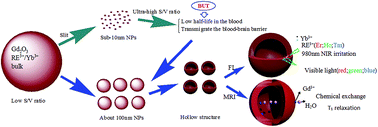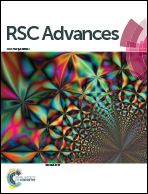Hollow-structured upconverting sesquioxide targeted nanoprobes for magnetic resonance and fluorescence combined imaging†
Abstract
Herein, hollow-structured Gd2O3 : RE3+/Yb3+ (RE = Er, Ho, Tm) nanoparticles (NPs) were prepared via a urea-based chemical coprecipitation method followed by subsequent calcination and etching. Under 980 nm near-infrared (NIR) irradiation, upconversion (UC) emission gains the highest intensity of red, green and blue peaks for Gd2O3 : Er3+/Yb3+, Gd2O3 : Ho3+/Yb3+ and Gd2O3 : Tm3+/Yb3+ NPs respectively. The corresponding fluorescence in-cell images exhibit bright visible light. The continuous color-tunable UC emission of each spectrum was investigated by increasing the concentration of the sensitizer Yb3+ ions from 0 to 20 mol% with the most intense red, green and blue emission achieved. The structure, morphology, components and magnetic property of Gd2O3 : Ho3+/Yb3+ NPs were investigated intensively. The results show that the NPs possess a distinctly hollow structure and uniform spherical shape, and are well-crystallized and highly monodispersed with a mean diameter of 118 nm. Due to the designed hollow structure which is of benefit to water contact of a large number of Gd3+ on the surface, the measured T1 relaxivity of the NPs is nearly 5 times larger than the relaxivity of the commercial gadolinium diethylenetriaminepentaacetate (Gd-DTPA). The relaxation enhancement in the hollow-structured Gd2O3 : RE3+/Yb3+ (RE = Er, Ho, Tm) NPs is addressed in the framework of Solomon–Bloembergen–Morgan theory. The biocompatibility studies in 293 and HeLa cells indicate that the hollow NPs have no observable cytotoxicity at a concentration up to 200 μg ml−1. All these results demonstrate that the hollow-structured nanocomposite has the potential to be developed into a safe and highly efficient magnetic resonance and fluorescence nanoprobe for in-cell molecular imaging of cancer.


 Please wait while we load your content...
Please wait while we load your content...